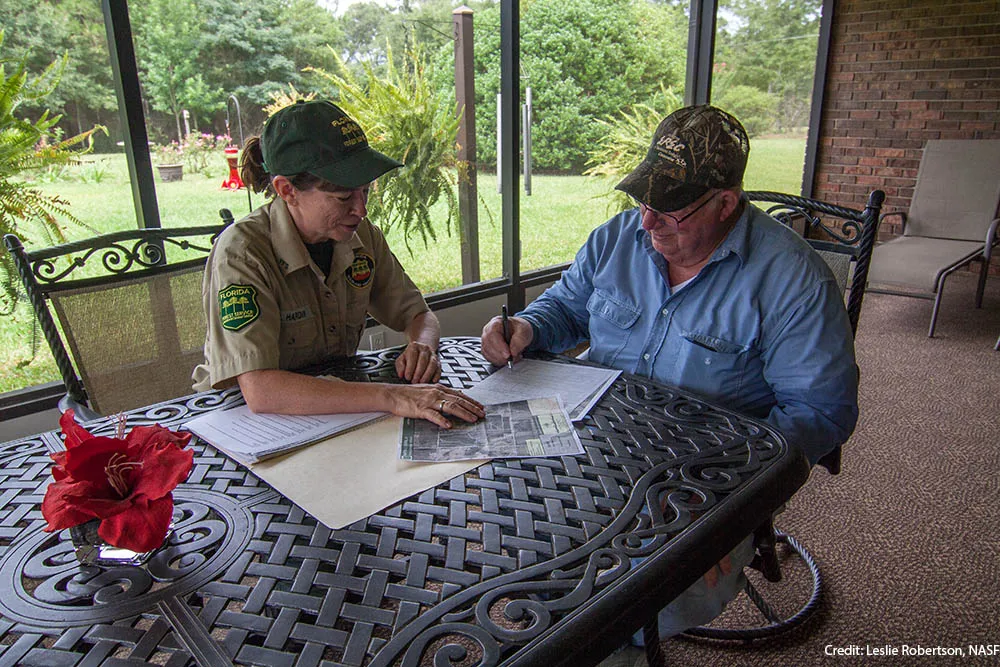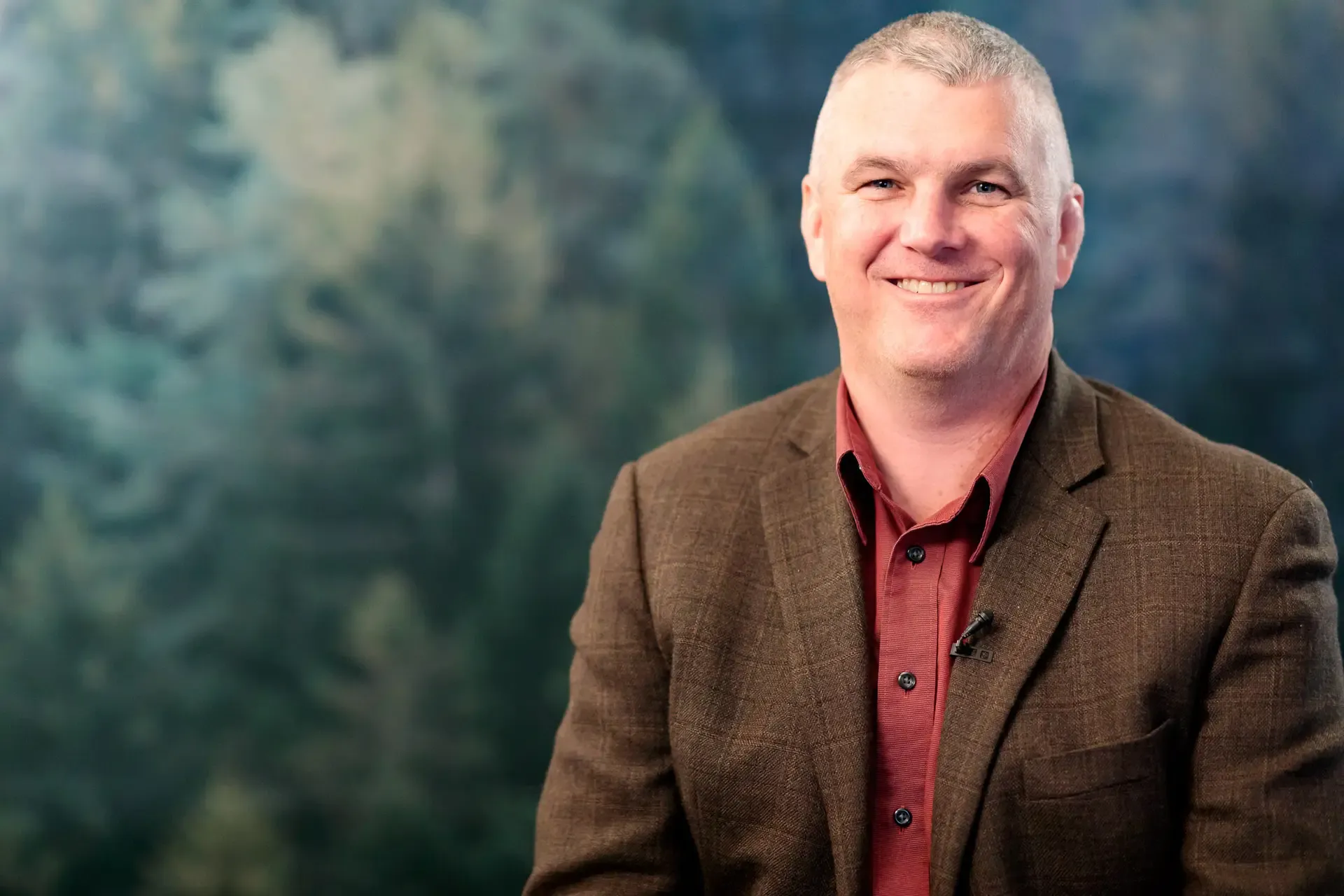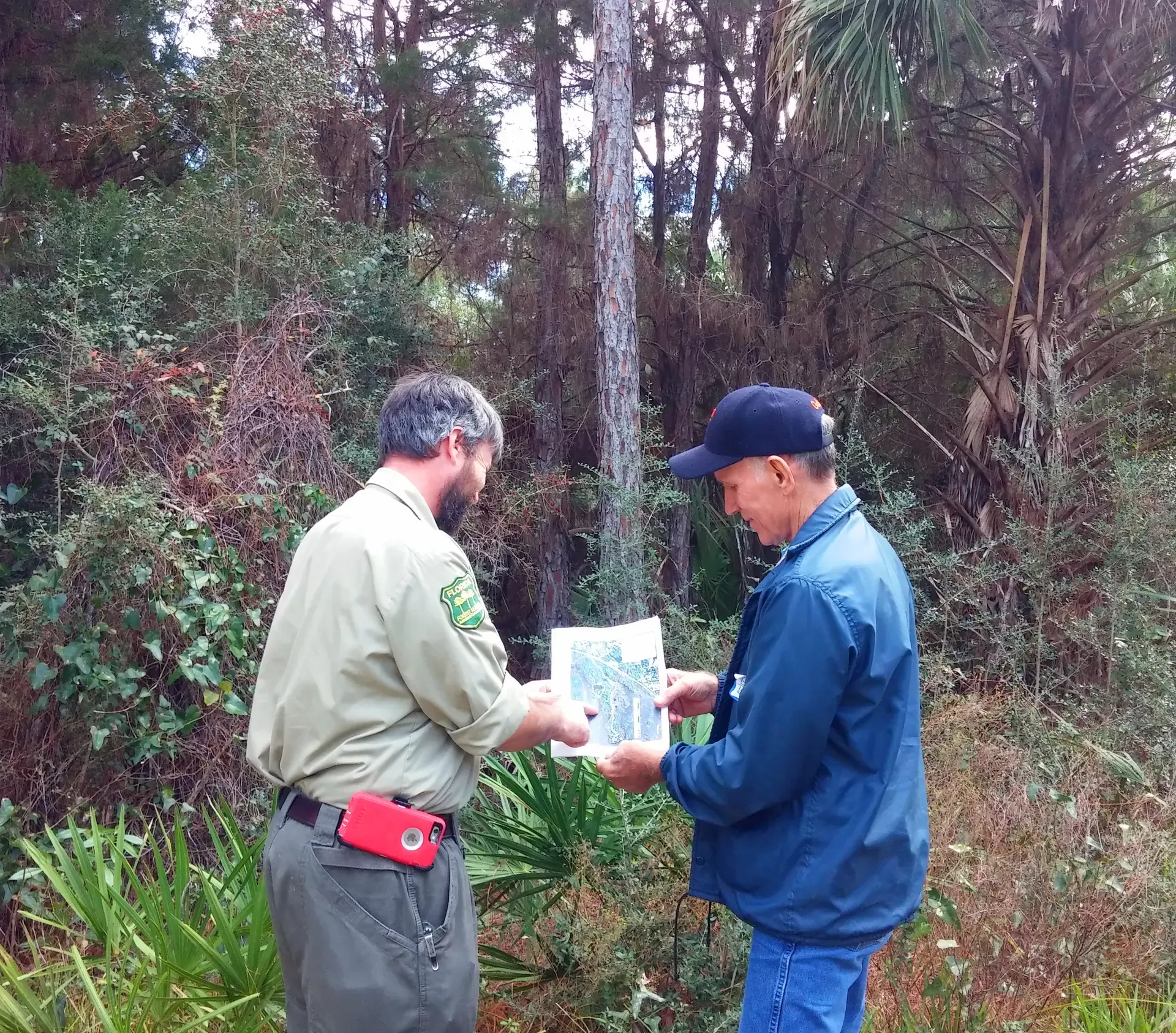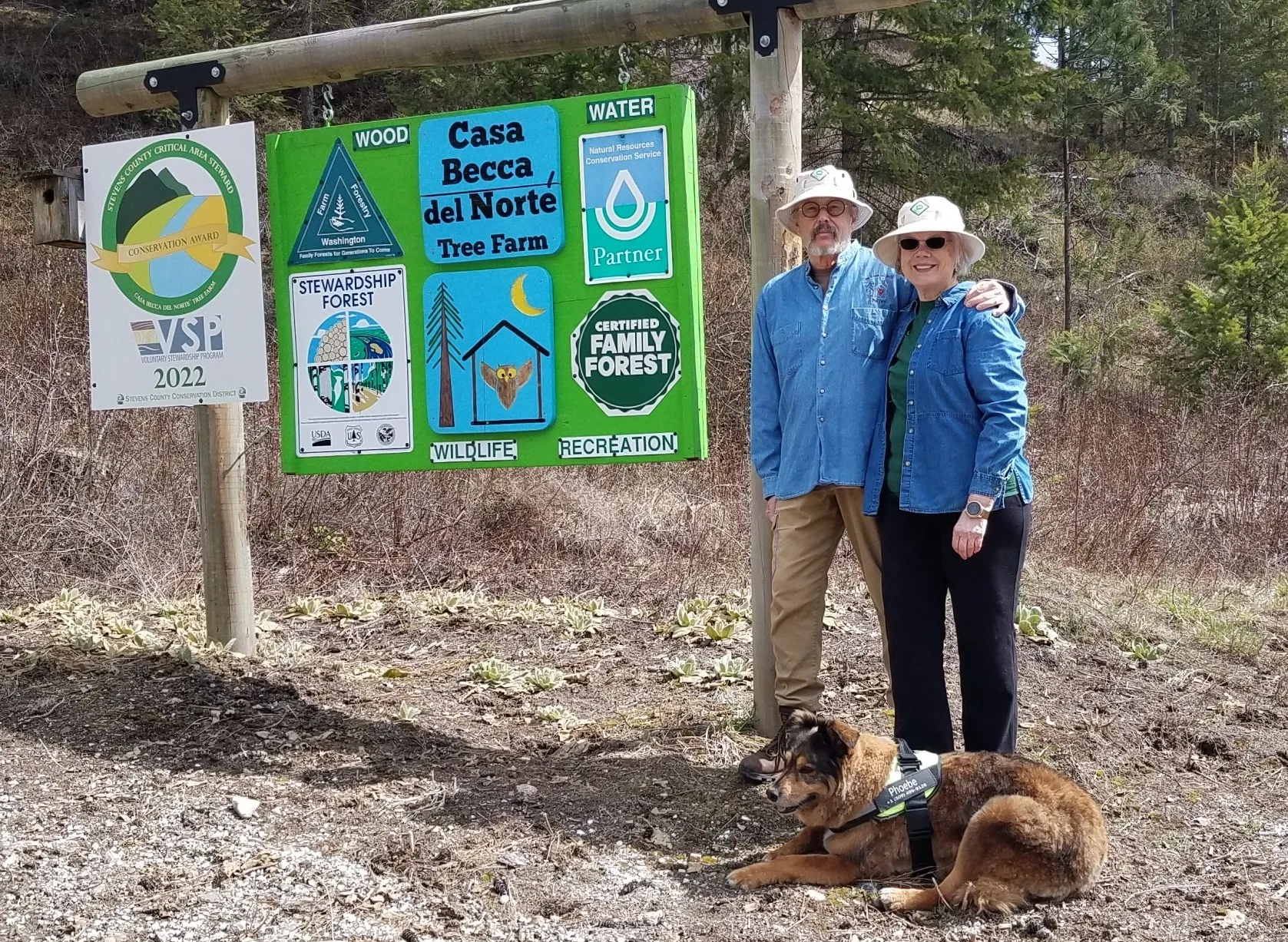A Forester's Perspective on the Landscape Management Plan

Florida forester reviewing management plan with a landowner. Photo courtesy of Leslie Robertson, NASF.
Across the U.S., there are more than 21 million family forest owners. These families and individuals collectively own the largest portion of all the forestland from coast to coast. They want to do what’s right by the land, but many lack the expertise and resources needed to care for it and keep it productive.
That is why the role of a forester is so important.
Whether it’s with a county forester from a state forestry agency, industry forester or a private consulting forester, meeting with a forester provides a landowner with the information, resources and confidence needed to take the next steps to steward their land.
However, foresters who serve these landowners often struggle with having enough time to build relationships and provide meaningful guidance to them. This can significantly affect the number of landowners receiving assistance and taking action to care for their land.
When a forester meets with a landowner to walk through their forest, a landowner can explain their goals for their land and ask questions. In return, foresters provide advice and help landowners learn about their trees, soil, waterways, and wildlife.
Landowners and foresters agree – this time spent together is the most valuable thing a forester can provide to a landowner.
Just ask Greg Marshall of the Florida Forest Service and Florida Tree Farm Program, who has been working with landowners for 20 years. Greg’s experience as a forester has made him a key player in helping to understand the daily challenges of foresters and landowners working together, and developing solutions to overcome them.

Greg Marshall, a forester with the Florida Forest Service and the Florida Tree Farm Program.
"Landowners want to build trust with their forester. Their land is very special to them, and they want to feel that their actions were well informed. The face-to-face time is the best way to build a long-term relationship with their forester, and feel confident about their forest management decisions," shared Greg.
After meeting a landowner, a forester will go back to the office and develop an individual forest management plan. Not only does this document outline tasks, but it is also needed to enroll in the American Tree Farm System (ATFS), the Forest Stewardship Program and many landowner assistance programs.
However, due to the length and detail needed for each forest management plan, it can take days for a forester to write, or several weeks, depending on their workload. While a forest management plan is a critical administrative step, it also can be a significant barrier that prevents foresters from helping landowners get work done on the ground efficiently.
"As foresters, we want to help landowners accomplish their goals. However, moving from planning to actual action can take a long time, specifically because of writing forest management plans. This limits the amount of time we as foresters can spend with landowners and can delay stewardship activities, as well as enrollment in important sustainability programs like ATFS," Greg says. "What’s more, we know what moves landowners to action is that continued conversation and engagement with their forester, and a simple list of actions or operations, not necessary the forest management plan."
A Tool to Streamline thPaperwork Process - The Landscape Management Plan

The American Forest Foundation (AFF) in its work to help more landowners actively manage their land – is working to streamline administrative tasks for foresters and allow them to spend more time in the field with landowners. To aid in this, AFF has created a new tool, the Landscape Management Plan.
The Landscape Management Plan (LMP) is a credible region-wide forest management plan that foresters can offer landowners in place of having an individual plan written. The landscape management plan:
Is rigorously created with input from a variety of stakeholders, trained professionals, and scientists to ensure credibility and alignment with the ATFS Standards of Sustainability. It includes all forest types in that region, considers ecoregions and the geodatabase, and goes into full detail on silviculture practices.
Streamlines the certification and forest stewardship enrollment process for foresters by eliminating the need for a traditional forest management plan to be written. If a landowner’s goals align with those of the broader region, the landscape management plan can be used in place of having one created. This saves time for foresters and streamlines the process so they can expedite ATFS certification and get started on their land management.
Guides a landowner’s plan of action. The landscape management plan can be used as a reference to foresters to create a simple set of forest management recommendations for the landowner. This easy-to-digest guidance helps a landowner avoid getting bogged down in long, excessive documents and focus on action items.
Looks at forest planning from the landscape level, taking into account the entire forest ecosystem and prioritizing conservation needs across a region such as wildlife habitat, species biodiversity, and the clean water supply. This helps accomplish state agencies’ Forest Action Plans by pulling together many family landowners’ efforts towards a larger conservation goal.
Is web-based and easy to navigate. In today’s world of technology, it’s essential to be able to access information easily. The Landscape Management Plan is available online for foresters and landowners to access at any time.
"The Landscape Management Plan makes the paperwork process simpler," Greg describes. "Foresters have other tasks they handle as well, marking and selling wood, or assisting with prescribed burning, so simplifying the desk work is freeing up our time and giving us a chance to meet with more landowners, more often."
"The other thing that is great about the Landscape Management Plan is it includes all the different landscapes in a region, which is typically well beyond what a landowner would have on their property alone. So it helps foresters understand the entire area where they're working. Moreover, since it’s a web-based tool, landowners can access it and learn more about their property and the community around them. It's broadening people's perspective on forests."
The Florida Landscape Management Plan was kicked off in 16 counties across the panhandle of Florida beginning in the fall of 2018 as part of the My Florida Woods project. It was created in partnership with Florida Forest Service and ATFS Florida Tree Farm Program, as well as others.
The goals of the pilot are to connect more landowners with foresters, get them to action more quickly and to streamline the ATFS enrollment and certification process. Since inception more than 20 foresters have been trained on the landscape management plan and have started offering it to landowners.
As Greg describes the progress of the Landscape Management Plan: "The foresters using the landscape management plan find it faster and easier. We’ve also noticed it has helped with re-inspections [or re-enrollment] for lapsed individuals in the ATFS program. This is helping us with landowners who are already managing and doing good work, but don't necessarily want to go back through the process of having another management plan written, especially if they didn't reference it much the first time."
"This year we are focused on training more foresters, both county, and consulting foresters. We hope that the more people hear about it, its credibility and the efficiencies it is creating, the more foresters will begin using it to engage more landowners in enrollment in the Tree Farm and Forest Stewardship programs."
If you are interested in learning more about the landscape management plan, contact us at info@forestfoundation.org.
Related Articles

December 18, 2025
Improving Wildlife Habitat with the Family Forest Carbon Program
For many landowners, spotting a fox, songbird, or other wildlife on their property is one of the highlights of spending time on their land. In this post we look at some examples of management practices you may see in your FFCP forest management plan and how they help create the ideal conditions for certain wildlife species.

November 6, 2025
Meet the 2025 Outstanding Tree Farmers of the Western Region – Lynn and Becky Miner
Lynn and Becky Miner’s story is one of vision, perseverance, and transformation. When they first purchased their 100-acre property near Chewelah, Washington in 1992, it was far from the thriving, diverse forest it is today. They have poured their energy into turning “Casa Becca del Norte” (Becky’s House in the North) into a model Tree Farm, earning the recognition as 2025’s Outstanding Tree Farmers of the western region.

September 4, 2025
Nature is Worth Investing In: Breakthroughs in the Voluntary Carbon Market
As we head into Climate Week, it’s worth pausing to take stock of how far the voluntary carbon market (VCM) has come. For years, this space has been scrutinized, challenged, and even questioned—but over the past few years we’ve seen positive breakthrough after breakthrough, which shows just how much progress has been made.